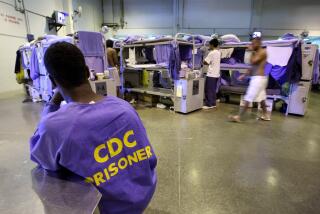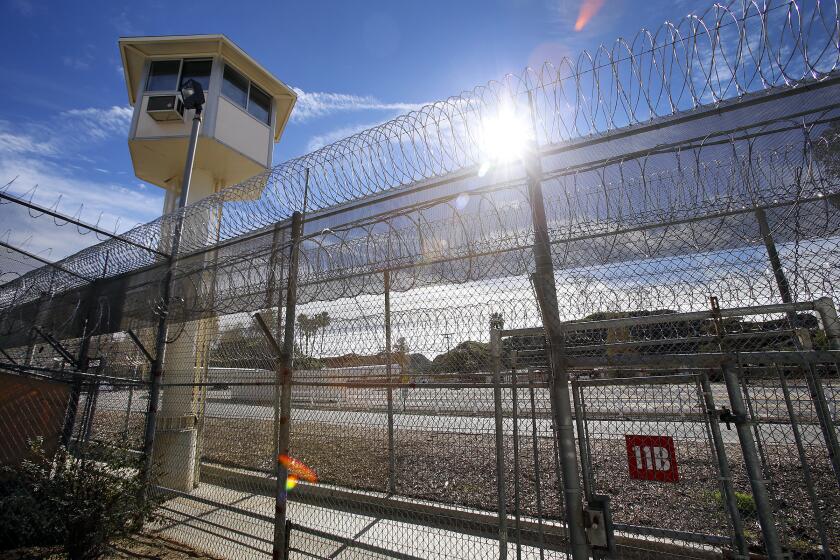Prop. 47 report finds fewer drug arrests, less crowding in jails
- Share via
Less than four months after California voters approved Proposition 47, the landmark law is already having significant effects on Los Angeles County’s criminal justice system.
A new report by the county chief executive office attempts to measure the effects of the law, which downgrades some drug and theft felonies to misdemeanors, though officials said it’s still far too early to draw final conclusions:
JAILS
In the county jails, overcrowding has eased, as people serving time on Proposition 47 charges are released and new offenders are not being locked up. This allows more serious offenders to serve a larger percentage of their sentences instead of getting out early.
Some people caught carrying drugs or drug paraphernalia are not being arrested at all. Narcotics arrests in areas patrolled by the Sheriff’s Department are down 38% from Nov. 5 to Jan. 5 compared with the same period a year ago, the report said.
By the end of January, according to the Sheriff’s Department, the decrease in narcotics arrests was even greater, down 48% from a year ago.
The report cites a drop in the jail population from about 18,000 inmates to 15,360 on Jan. 5. With some county-sentenced inmates serving more time, the population has since rebounded to about 17,000, according to the Sheriff’s Department.
COURTS
Local criminal courts will process 4,000 to 14,000 applications from pretrial defendants who were arrested for felonies but can now have their charges reduced to misdemeanors, the report said. An additional 20,000 applications could come from people currently incarcerated, the report said.
Another category of cases is expected to keep judges, prosecutors and public defenders busy: the people who have already served their time and can now change the felonies on their criminal records to misdemeanors. Those cases could top 300,000 and date back decades.
The report quantifies a widely expected impact on court-ordered drug treatment programs: a decrease in enrollment because defendants are no longer threatened with much jail time. Sign-ups for the programs dropped from 99 defendants a year ago to 49 in the first two months after Proposition 47 passed.
Proposition 47 could prompt a “total redesign” of some county drug treatment programs, said Holly McCravey, an official who oversees those programs.
“Now since we don’t have a hammer — maybe the hammer was a little too strong — I think the county has to focus a little more on how do we actually engage this population and get them into the services they need,” she said.
Misdemeanors can also be used as an incentive to enter treatment if the customary penalties are increased, said Lenore Anderson, executive director of Californians for Safety and Justice, which coordinated the campaign to pass Proposition 47. Defendants can — but rarely do — receive up to a year in jail.
“We had had for a long time a system overrun by felonies. Now we’re in transition period, and we can adapt,” Anderson said. “Holding a year over someone’s head is a consequence.”
PROBATION
The county Probation Department has seen a reduction of about 3,000 cases from the same time last year, probation officials said Wednesday. The bulk of the offenders who had been on felony probation and have had their crimes reduced to misdemeanors under Proposition 47 have either been released from probation or placed on a lower-level type of probation in which they are required to stay out of trouble but not to check in with a probation officer. But department Chief Jerry Powers noted that most of the decrease has been in lower-risk offenders who were not receiving intensive monitoring or services in the first place.
The report also noted that the reduction in probation caseloads could be countered by a new state law requiring “split sentences” with jail time followed by probation in many cases.
MENTAL HEALTH
The county’s mental health system is also adjusting to Proposition 47. As inmates with serious mental illness, including those declared incompetent to stand trial, are released earlier than expected from state hospitals, they will require county mental health services, which means a longer wait for others in need of those beds.
“It’s impacting everything,” said Mary Marx, district chief for the Department of Mental Health. “It’s a domino effect.”
In the jails, the proportion of mentally ill inmates increased slightly, from 18% to 20%, according to the report, with more of them acutely ill than before Proposition 47. But Dr. Stephen Shea, the county’s medical director for jail mental health programs, said Wednesday that the initial increase appeared to be a temporary “blip” and has since stabilized.
MONEY
Initially, there will probably be less money available to help crime victims. Those convicted of misdemeanors pay less in fines than felony offenders, so the amount of money in the state’s victim restitution fund will decrease. Victims of Proposition 47 crimes will not be eligible for county victim assistance, because misdemeanors are not included in the program.
But beginning in July 2016, any money the state saves from Proposition 47 will be used for victim services as well as treatment and youth programs.
According to the Los Angeles County district attorney, the Proposition 47 money could be used for additional staff to work with victims, including interpreters for victims not fluent in English.
The report includes a preliminary list of county programs that could benefit from the future Proposition 47 money. These include urgent care centers for the mentally ill, substance abuse programs, a six-month program for juvenile offenders and a post-release program for juveniles coming out of probation camps.
cindy.chang@latimes.com
abby.sewell@latimes.com
More to Read
Sign up for Essential California
The most important California stories and recommendations in your inbox every morning.
You may occasionally receive promotional content from the Los Angeles Times.















